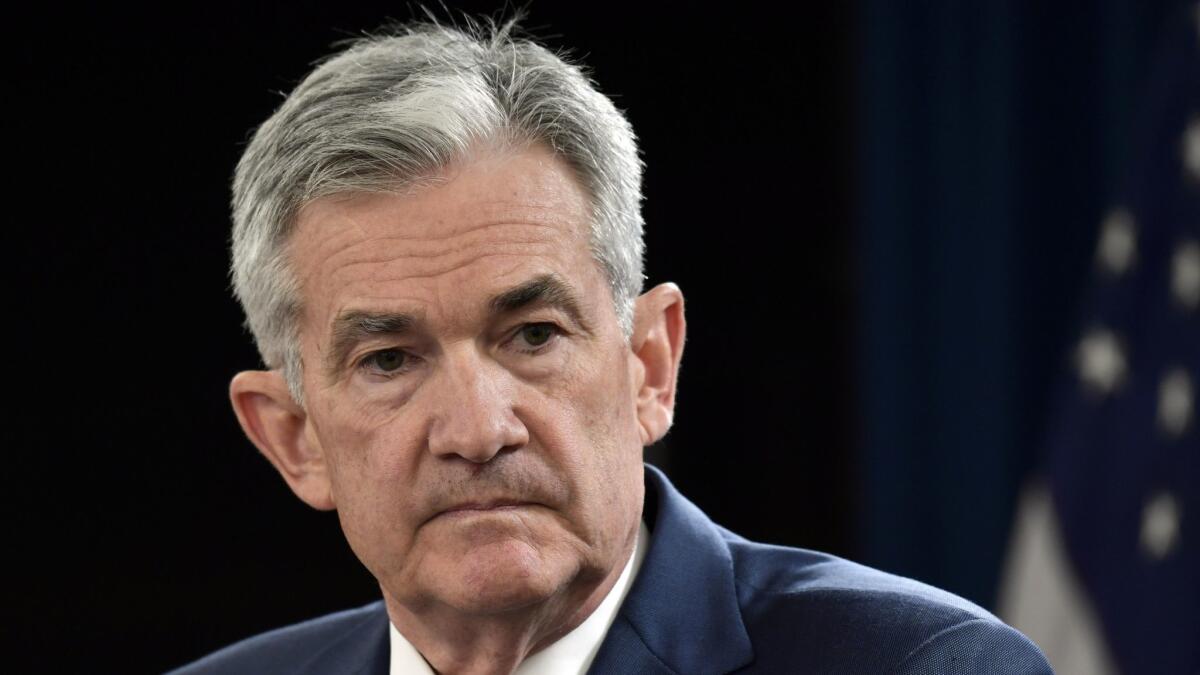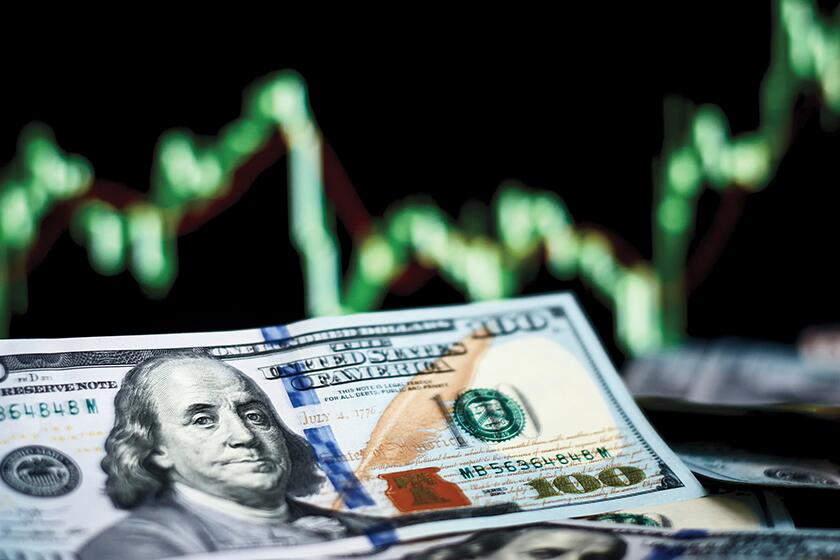Stock market soars on speech by Fed chief, who says no ‘preset policy path’ for future rate hikes

- Share via
Reporting from Washington — Federal Reserve Chairman Jerome H. Powell is under pressure from President Trump and investors to slow interest-rate hikes that could dampen economic growth, but that pressure doesn’t seem to be swaying him.
In a highly anticipated speech Wednesday that sent the stock market soaring, Powell appeared to successfully thread a needle: calming investors about future rate hikes while reiterating the Fed’s independence — noting rates remain historically low and the central bank will continue raising them as needed driven only by the relevant data.
Powell was mostly upbeat about the U.S. economy, forecasting “continued solid growth, low unemployment” and inflation near the Fed’s 2% annual target in his speech to the Economic Club of New York.
“There is a great deal to like about this outlook. But we know that things often turn out to be quite different from even the most careful forecasts,” Powell said, adding — as he and other Fed officials often have — that “there is no preset policy path.”
“We will be paying very close attention to what incoming economic and financial data are telling us,” Powell said.
The Dow Jones industrial average, which had already risen in morning trading, jumped nearly 200 points after Powell’s prepared remarks were published. The index closed the day up up 2.5%, or 618 points, to 25,366.
Investors have been jittery about the prospect of continued interest rate hikes and they appeared to react positively to Powell saying that the Fed’s short-term interest rate is “just below” the so-called neutral range — the level at which the rate isn’t speeding up or slowing down growth. In early October, Powell had said the rate was “a long way” from neutral.
But Powell’s comments Wednesday were more subtle. In this speech, he said the rate was “just below the broad range of estimates” of the neutral level for the benchmark federal funds rate.
That range is between 2.5% and 3.5%, so Powell wasn’t necessarily saying that the Fed was close to ending its rate hikes even though investors took his remarks as good news.
Powell “was not, in our view, signaling any impending change” in the Fed’s rate hike outlook, said Ian Shepherdson, chief economist at Pantheon Macroeconomics.
Fed monetary policymakers are widely expected to inch up the central bank’s key short-term interest rate by 0.25 of a percentage point to a target range of 2.25% and 2.5% when they meet Dec. 18 and 19. It would be the fourth hike this year.
In their last forecast, in September, Fed officials indicated there would be three more such hikes in 2019.
The federal funds rate is only one hike away from the low end of the neutral range estimate, but still three hikes from the midpoint and five from the top end, Shepherdson said in a research note.
“As always, the Fed ultimately will do what the data tell them to do, and we think the 3.7%-and-falling unemployment rate leaves policymakers very little room for maneuver” away from additional rate hikes, he said.
Powell said this month that the central bank could slow its pace of rate hikes if economic growth slows significantly next year.
Economic growth slowed in the third quarter to an annual pace of 3.5% from 4.2% the previous quarter. It is expected to slow further in the fourth quarter as the stimulus fades from the tax cuts that took effect Jan. 1.
Powell also pointed to some concerns about overall financial stability, including the Fed’s own efforts to slowly bring interest rates up to a more normal level after years of keeping them at an unprecedented low level to stimulate the economy during and after the Great Recession.
Other risks include “the unsettled state of trade negotiations” — a reference largely to the U.S.-China trade war — the Brexit negotiations in Europe, high corporate debt loads and some overvalued stocks.
But his concerns about stocks did not rise to the level of thinking there’s a dangerous bubble.
“From the financial stability perspective ... today we do not see dangerous excesses in the stock market,” Powell said.
Powell’s remarks summarized the findings of the Fed’s first report on financial stability, released Wednesday.
The report raised warnings about the apparent deteriorating credit standards for some business loans during the last six months. It noted the share of large, newly issued loans to highly leveraged corporations “now exceeds previous peak levels observed in 2007 and 2014 when underwriting quality was notably poor.”
Still, the default rate on those loans has been low, partly reflecting the strong economy, the report said.
Powell’s speech was given amid Trump’s extraordinary public criticism of the Fed. He said this week he was “not even a little bit happy” with Powell, who took over as chair of the central bank in February after Trump nominated him to replace Janet L. Yellen.
Trump blamed the Fed for recent stock market declines and for General Motors’ decision to lay off workers and close five North American factories, including assembly plants in Ohio, Michigan and Maryland.
“I’m doing deals, and I’m not being accommodated by the Fed,” Trump told the Washington Post on Tuesday. “They’re making a mistake because I have a gut, and my gut tells me more sometimes than anybody else’s brain can ever tell me.”
The dispute over the rate hikes reportedly prompted Treasury Secretary Steven T. Mnuchin to look for a more subtle way for the Fed to raise interest rates, which could allow the central bank officials to avoid Trump’s ire.
Bloomberg reported that Mnuchin privately asked bond dealers and investors in an Oct. 30 meeting whether they preferred that the Fed tighten monetary policy by raising its key short-term interest rate or by speeding up the sale of long-term bonds in the central bank’s portfolio.
Twitter: @JimPuzzanghera
UPDATES:
1:15 p.m.: This article was updated with the close of New York markets.
Noon: This article was updated with additional details and comments from Ian Shepherdson of Pantheon Macroeconomics.
This article originally was published at 10:10 a.m.
More to Read
Inside the business of entertainment
The Wide Shot brings you news, analysis and insights on everything from streaming wars to production — and what it all means for the future.
You may occasionally receive promotional content from the Los Angeles Times.











